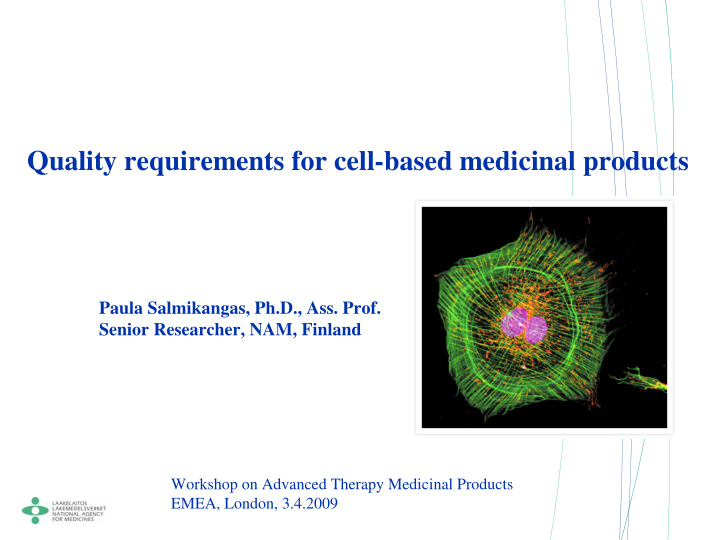



Quality requirements for cell-based medicinal products Paula Salmikangas, Ph.D., Ass. Prof. Senior Researcher, NAM, Finland Workshop on Advanced Therapy Medicinal Products EMEA, London, 3.4.2009
Cell-based Medicinal Products � Cell Therapy Products � Tissue Engineering Products � Autologous, Allogeneic, Xenogeneic
Existing legislation and guidance concerning CBMPs � Regulation 1394/2007/EC � Directive 2001/83/EC, Annex I, Part IV (under revision) � Directives 2004/23/EC, 2006/17/EC, 2006/86/EC � Guideline on Cell-Based Medicinal Products ( EMEA/CHMP/410869/2006) � Guideline on Xenogeneic Cell-Based Medicinal Products (CPMP/BWP/3326/99) (under revision)
What makes cells different? Environmental signals Cells are not inert material, they respond to external signals!
New regulatory approach for CBMPs � Limitations (limited sample sizes, short shelf life) vs. particular risks (microbiological purity, variability, consistency) � wide variety of products (autologous, low manipulation ��� allogeneic / xenogeneic, stem cells, genetic modification etc.) � A risk-based approach can be applied for cell-based products (Dir. 2001/83/EEC, Annex I) � The risk analysis should cover the whole development and should be used to determine the amount of data needed in the MAA
Quality Safety Efficacy • Microbiological purity • Dedifferentation / loss of function • Cellular impurities of cells • Process-related impurities • Cellular impurities • Cell transformation / malignancies • Cell transformation • Immunogenicity • Ectopic engraftment to non-target tissues
Risk mitigation by quality management � Appropriately defined product (characterisation) � Good quality starting materials � Validated, aseptic manufacturing process � Feasible quality control system (IPCs, release, stability and comparability testing) � Suitable, validated analytical tools
Starting materials � Origin of cells ( autologous, allogeneic, xenogeneic) � Viral and TSE safety � pooling of cells should be avoided / justified � Banking requirements according to ICH Q5D and Annex I � Non-cellular components � Viral and TSE safety � Suitability for the intended use � Quality and characterisation (functionality)
Product characterisation / testing � Identity � Purity � Impurities, sterility � Potency � Karyology / Tumourigenicity � Biocompatibility
Identity � Identity parameters should be established for all components of the product � identity of the cellular components should be based on phenotypic and/or genotypic markers � the test method(s) should be specific for the cells / product � when addressing phenotype, relevant markers could be used (gene expression, antigen presentation, biochemical activity etc.) � for allogeneic cells, identity should include histocompatibility markers, if applicable � For adherent cells, morphological analysis may be a useful tool in conjunction with other tests
Chondrocytes Osteoblasts Adipocytes Skeletal muscle cells PromoCell
Cell purity � where a specific cell type is required for the indication, other cells are impurities and should be tested / controlled for, if applicable � where a complex mixture of cells is required, the cell composition should be properly defined and controlled (IPC, release testing) � irrespective of the cell type, the product may contain non-viable cells as contaminants (not biologically active) � specification for viable / non-viable cells should be set � the methods used for purity evaluation should be carefully chosen (cell morphology ?, FACS?, others?)
Cell identity / purity by morphology Fibroblasts Adult stem cells
With appropriate markers, contaminating cells can be detected � FACS (suspension cells, adherent cells?) � Fluorescent microscopic analysis (adherent cells)
Impurities, sterility � product-related impurities (e.g. cell fragments) � process-related impurities (antibiotics, cell culture reagents etc.) � all impurities should be addressed in the risk analysis and clinically significant impurities should be tested and/or their removal demonstrated through validation � sterility testing according to the Ph.Eur.; if not possible, sterility tests should be performed as IPCs and/or alternative testing could be considered (e.g. BactAlert) � testing for the absence of bacteria, fungi and mycoplasma from the final product, if possible
Potency � demonstration of potency / functionality of the cells is one of the key issues for MA � should be based on the intended biological effect which should ideally be related to the clinical response � should detect clinically meaningful changes in the product (loss of function, dediffentation etc.) � in vitro assays / in vivo assays or assays based on surrogate markers (gene expression profiles, flow cytometric immunoassays etc.) � different products, differing assays (e.g. structural analysis for tissue-like products, immunological assays for immunotherapeutic products etc.); multiple assays if necessary! � don´t mix assays for potency and purity!
Correct differentiation of chondrocytes De-differentiation of chondrocytes
Karyology, tumourigenicity � cellular transformation or chromosomal instability may require testing for tumourigenic potential � stem cells � extended cell culture periods, cell banking � e.g. growth factors used in cell culture etc. � requirements for the testing can be found in Ph.Eur. and ICH Q5D
Biocompatibility /combined products � the quality studies shall be designed and performed with the Combined Product as a whole � testing for components / degradation products that may be toxic � testing to confirm that the system maintains the desired cell differentiation, functionality and genotype during production � functional test(s) for the cellular component essential; testing for the ECM, if important for the intended function � dose definition � structural components should be tested for most important characteristics (e.g. topography, surface chemistry, strength) when combined with cells � limited possibilities for batch release testing; quality ensurance through process validation and appropriate characterisation
Production � aseptic manufacturing process � process validation / consistency � all hold steps (incl. freezing) should be validated � stability evaluation / formulation � feasible quality control system � what tests are best suited as IPCs � which are the most critical parameters of the product and need to be evaluated at release � what aspects could be solved through process validation
CHO cells, plated under different conditions, exhibit different cellular morphology. (Bucher Biotech) Cells do change when culture conditions are changed! � When do the phenotypic changes result into genotypic changes? � Is comparability testing possible for cells?
Additional information can be found from: Guideline on Cell-Based Medicinal Products EMEA/CHMP/410869/2006 Thank you!
Recommend
More recommend